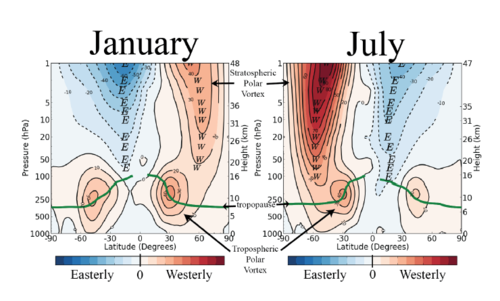Polar vortex
polar vortex
The tropospheric polar vortex is usually defined by geopotential contours that lie within the core of the tropospheric westerlies.1 The tropospheric vortex edge is generally between 40º and 50º latitude (Fig. 1), and the vortex exists throughout the year but is strongest during winter when the air within the polar vortex is the coldest.
The term “polar vortex” is sometimes used in reference to smaller-scale (meso- to synoptic scale) vortices that usually occur within the tropospheric polar vortex in polar regions near the tropopause—for example, “tropopause polar vortices.”2
The stratospheric polar vortex exists from fall to spring and usually extends from just above tropopause to the upper stratosphere (see Fig. 1). The stratospheric vortex generally increases in size from the lower stratosphere to the upper stratosphere where its edge is located around 50º latitude. The stratospheric vortex breaks down, and the circumpolar flow reverses, during summer.3
Circumpolar vortices have also been observed on other planetary bodies (e.g., Mars, Venus, Saturn, and Titan).4
FIG. 1. Zonal mean wind in (left) January and (right) July in the troposphere and stratosphere from 1979 to 2014. Westerlies (winds from the west) are warm colors with solid contours while easterlies (winds from the east) are cool colors with dashed contours. Units are in meters per second, with a contour interval of 10 m s–1. The tropopause is displayed by a solid green contour and is defined here as the 2-PVU surface, where 1 PVU = 10–6 K kg–1 m2 s–1. The westerly (easterly) wind maxima that define the edge of the stratospheric polar vortex are denoted by the “W” (“E”) symbols at each height level. Data source: ERA-Interim reanalysis. Figure courtesy of S. Cavallo.
References:
1Frauenfeld, O. W., and R. E. Davis, 2003: Northern Hemisphere circumpolar vortex trends and climate change implications. J. Geophys. Res., 108, 4423, doi:10.1029/2002JD002958.
2Cavallo, S. M., and G. J. Hakim, 2010: Composite structure of tropopause polar cyclones. Mon. Wea. Rev., 138, 3840–3857, doi:10.1175/2010MWR3371.1.
3Schoeberl, M. R., and D. L. Hartmann (1991), The dynamics of the stratospheric polar vortex and its relation to springtime ozone depletions, Science, 251, 46–52.
4Read, P. L., 2011: Dynamics and circulation regimes of terrestrial planets. Planet. Space Sci., 59, 900–914, doi:10.1016/j.pss.2010.04.024.
(Term Edited 30 January,2014 and 6 October 2015)

